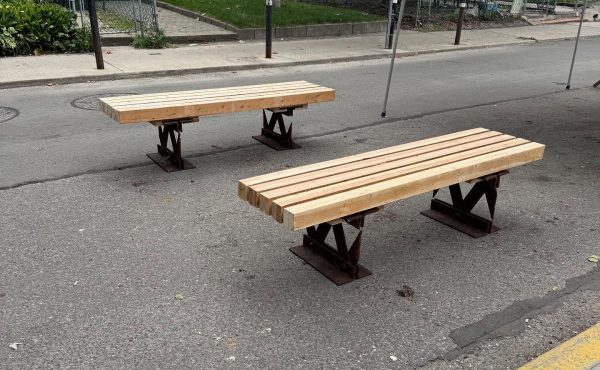
This past week’s Eye Weekly Stroll column had me climbing around the hills of York, the unsung city that once existed as part of Metropolitian Toronto until amalgamation.
York is not easy to find, as it’s completely landlocked and asymmetrically shaped, with very few overt signs that you are, in fact, there. It roughly lies west of Bathurst, between St. Clair and Eglinton, to the Humber River and Weston area, with a few municipal tentacles reaching in various directions.
…
The area beyond Dufferin south of Eglinton is one of Toronto’s unique neighbourhoods. Though it has no defining style, and even the most passionate Toronto booster would not call it beautiful, the topography makes this area charming. Built on a series of hills and valleys, streets make sharp turns and dead-end abruptly, sometimes at a grade that looks too steep for cars. Toronto has been called “San Francisco upside down†because of its many deep ravines (as opposed to hills), but this part of Toronto could easily be “Little San Francisco†— though instead of multi-million dollar Nob or Russian Hill homes, the York counterpart has treeless lots with brick bungalows, rusting Buick Centuries and Pontiac Fieros parked out front and copies of the Toronto Sun in the blue boxes, tiny manicured lawns and lots of interlocking brick. There are numerous Mary Poppins—style views above rooftops and chimneys, as well as parks with secret escapes up outdoor staircases.
Read the rest here. The “San Francisco upside down” idea comes from Robert Fulford’s 1995 book Accidental City: The transformation of Toronto. It — along with John Bentley Mays’ Emerald City — was one of the first books I read about Toronto when I moved here and complemented my own ambulatory explorations. Above, and below, are some photos taken along Rogers Road. Not terribly pretty, but one of Toronto’s most interesting bits of road.

Old Weston Road / Rogers Road intersection. Portuguese restaurant, a sort of rounded and stunted flatiron building.


Ungentrified Rogers Road is what a lot of Toronto used to look like and will remind longtime Torontonians of various parts of the city from different eras.


Keele and Rogers — a surprisingly colourful corner. The Solara Condominium above is one of Toronto’s strangest buildings — a good idea plopped on top of a parking garage.


Diverse housing stock along Keele.


Lots of light industrial uses found in the area, tucked in among the residential zones. Beware of the junk yard dog at Mr. Collision. He was not happy to see me.


Rogers Road skyline.




6 comments
Great article as always!
I ride my bike through York a lot and it’s truly like riding back in time. Despite having the distinction of being Ontario’s poorest city for many years, it never really felt that bad to me. Just a thoroughly working-class node whose seen better days (and may one day again). I also think it probably holds a lot of long-term potential (if you are in the property market).
The hills are great though. There’s this one part of Rogers Rd where it feels like you are riding along a summit and all the north-south residential streets just fall away from the road.
It’s also interesting how even pre-amalgamation nobody really called York, York. People would refer to their intersection or their neighbourhood (ie. Weston).
I think York also has the distinction of being the only pre-amalgamation jurisdiction without community centres.
Very timely article for me. I just bought a house on Atlas Avenue – one of those streets that are directly south of Allen Road and Eglinton – the borderline between the good, bad and the ugly as I call it. The house was a steal as far as comparable homes go even a street over to the east (Cedarvale) but still more expensive than even a street or two over to the west around Oakwood. Will be interesting to see what this area does in the near future and if the Forest Hill effect will spread west (or alternatively, if the Oakwood effect will move east!!!).
I live in the Oakwood/Vaughn area, and I love it!
York is a fasinating place. It’s neither suburban or really urban, but the border between York and Toronto feels really arbitrary, likewise with the York/North York border. The only way to tell you’re crossing from Toronto is the switch in the street signs from the white acorns to the blue lower-case letters, and the street lamps from the classic white bulbs to the short sodium lamps.
I notice the rather sudden change in York west of Winona along Vaughan as well – I am curious as to what will happen in the next 10 years.
The area where Keele/Rogers/Old Weston Road converge is rather interesting. I remember when the remnants of the Rogers Road Streetcar Line were still visible around there, a streetcar that was abandoned in 1975 (the last streetcar line to disappear in Toronto), yet the tracks remained for 25 years after.
York also had a strange distinction of once being the largest city in North America without a McDonald’s. Sure, there were some McDonald’s in the perphery – St. Clair/Christie, Crossroads Centre, Keele/Ingram, but not in York itself.
I live in York, one boring ass place.
This area would be great if the city investested in infrastructure, more police and cosmetic upgrades. We are close to all. The area has a lot of potential we just need to bug our MP’s to get off their behinds and notice our side of the city.